1945
The “ Stone American” was designed and scultured by Cpl. Lester Fried. Cpl. Lester Fried was already welknown on the base for painting nose art and whatever on jackets but is also for designing the squadron patches and painting the first mock-up of the ‘Fireball’ group insignia that hung in the officer’s club.
Cpl. Fried first made a clay model of the statue that was sumitted for approval which was given shortly afterwards. The group was getting ready to leave for the USA and so the building process needed to be quick. Cpl. Fried made the bust and the wreath himself. The pedestale was done by a member of the group who was a former bricklayer. When the pedestale was ready Cpl. Lester Fried noticed the width of the base being wider then intended. The brick base wasn’t given enough time to cure before the cement outer coat was applied. The bust was anchored to the base by means of an inverted ‘U shaped bar’, Cpl. Fried cemented to it which was in turn sunk into wet cement in the center of the base, after a couple of days the pedestale was given a coat of whitewash and Cpl. Fried applied gold pant to the statue and the wreath.
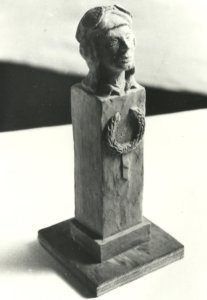
May 31st 1945
On this day a group of men from the base assembled on the cementery of the Connington Church to unveil the monument that was recently build and placed to commemorate those who would never return home again. Colonel Rogner had the honor of unveiling the monument (pulling a parachute from the top of the monument), with Cpl. Lester Fried, a large number of servicemen, dignitaries and villagers in attendance, and Canon Wayne of Connington Church delivered the blessing.
In the Daily Bulletin (Army Air Force Station 130) of June 3rd 1945 this message was send out:
“Notice: ATTENTION ALL PERSONNEL – every member of this station is urged to visit Conington Churchyard and view the Memorial bust to the American Airmen of the 457th Bomb Group who gave their lives in this World War II. The bust is located in the north side of the curchyard. This monument was unveiled on 31 May 1945 by thwe Station Commander and Cpl. Lester Fried, who designed and constructed it. Pay a visit and spend a moment’s quiet reflection in memory of those who came over but will not return.”
Many members visited the memorial just before leaving homewards. Many former 457th Bomb Group veterans and their families visited the memorial in the years after the war. The memorial is also visited during our UK reunions. Here is a small collection of men visiting the memorial.
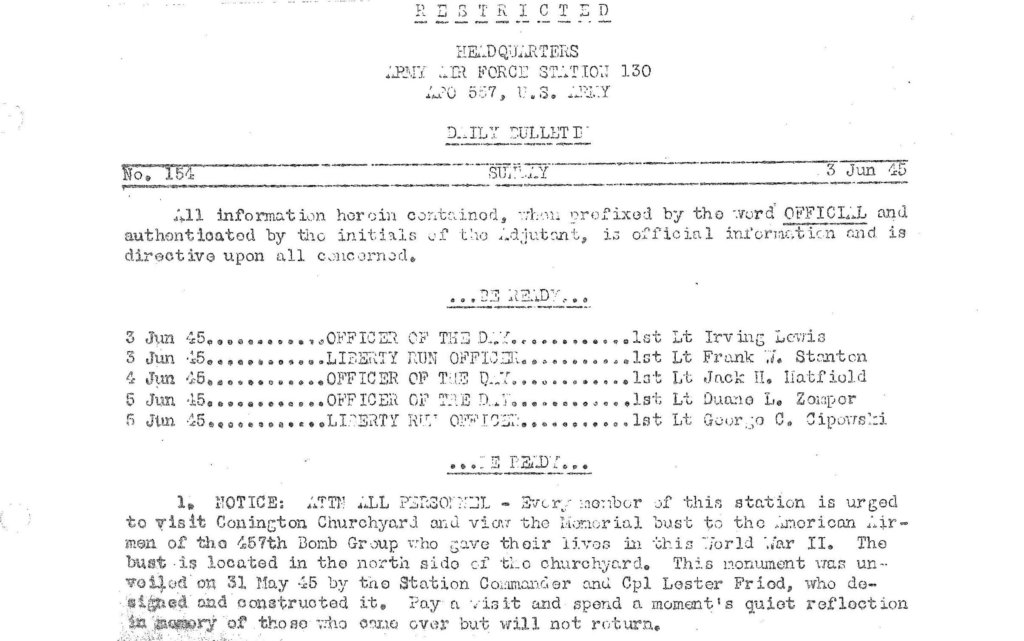
June 5th 1945
Cpl. Lester Fried receives a commendation from Colonel Harris E. Rogner for the work he has done on the memorial.
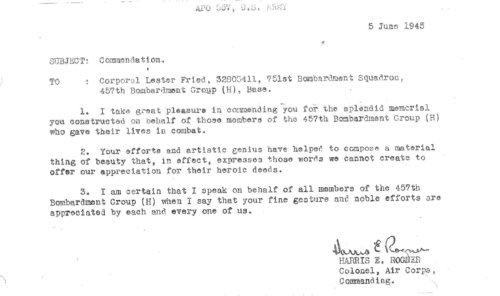
November 23rd 1956 (paper from RAF station Alconbury)
Base Protestant Congregation To Restore American War Memorial
 The Rev. E.A. Bishop, Rector of Connington Church, explaining repair work needed on memorial to Chaplain (Capt.) William L. Shoemaker, Alconbury’s Protestant Chaplain
The Rev. E.A. Bishop, Rector of Connington Church, explaining repair work needed on memorial to Chaplain (Capt.) William L. Shoemaker, Alconbury’s Protestant Chaplain
During World War II the air base at Connington, located about half way between Alconbury and Peterborough, was operated by American personnel. To honor the men that did not return from the missions, the base, with consent of the inhabitants of Connington, erected a memorial in the church yard.
After almost 12 years in the church yard, the monument began to shoiw the effects of the English weather. The finishing layer of cement on the pedestal was cracked in many places and the birght red color of the brick was visible. A small crack also appeared on the neck of the statue, and it became apparent to the congregation of the church that the memorial would have to be fixed before it was beyond repair.
The Rev. E.A. Bishop, rector of the Connington Church, contacted Chaplain (Capt.) William L. Shoemaker, Alconbury’s Protestant Chaplain, and told him of the situation. The Protestant congregation decided it was fitting that the £10 needed to restore the memorial be donated.
The memorial is a cast cement bust of a crewman’s head, complete with helmet, goggles and earphones. It is mounted on a cement finished brick pedestal about five feet high with the stone carved wreath with the Latin phrase meaning “ Well done” decorating the front. On the rear of the head is the name Lester Fried, USA, 1945; who may have been the one who made the bust.
August 1975
Homer Briggs visits the old airfield. The photo of Homer and the memorial shows the bad shape the Stone Airman was in.
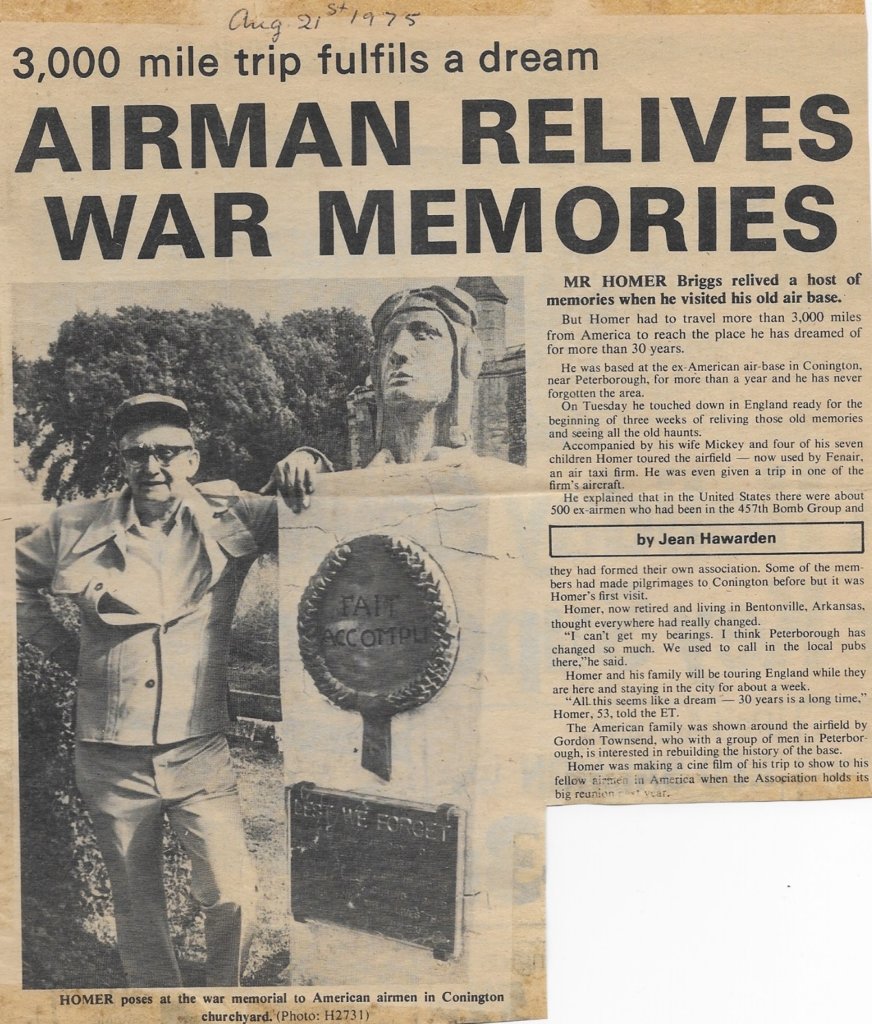 (photo credits Sheila Holtzen)
(photo credits Sheila Holtzen)
February 1978 (from the newsletter)
We have heard from Lester Fried of New York. He writes that he designed and sculptured “ The Stone American” monument in Connington Cemetery. He enclosed Xerox prints from his personal album that show the ceremony on May 31, 1945. Enclosed was a copy of the commendation letter he received by Col. Rogner together with a portion of the Daily Bulletin that referred to the monument, urging members of our group to visit it for a ‘moment’s reflection’ in honor of those who would not return.
Lester says: “I am very pleased to find out that there is a caretaker for the “Stone American”, by the way, who gave it that name?” Later as most of you know Dan Graham of Indiana went on to get the monument repaired and he enlisted the help of the first reunion attendees to get the present plaque done and sent over to be attached to the monument.
Also in this newsletter a message from Sawtry, England:
George Townsend has written that repairs have been made to the outside of the church in Glatton Cemetery where “ The Stone Airman” monument is located. He writes “ I have tried to repair the memorial, but I am afraid it is now beyond me. I have a man in the building trade who looked at it. It should come down and be rebuilt up with faceing brick and it will not want painting or plastering again ever. It also needs a slab on the top to shoot the water off, because water getting in, is what is causing all the trouble. If we want the man to he will send us an estimate and carry the job out properly, if decided to be done.”
You as members in good standing should write to the board or President, Vice Pres. And give them your opinion, also as how to pay for this, so that the Board and Officers can decide what is to be done. In the meantime I, Homer Briggs will write for an estimate on the cost. We have already looked into the Airforce to repair and they will not do this.
January 1979 (from the newsletter)
Reports from England say that the monument is in badly need of repair. Suggestions may be sent to President Bill Siles on how to go about paying for this, then it can be discussed at the July 1979 reunion. Any other discussion should be sent to Bill, so that research can be done and brought before the attendees.
October 1980 (from the newsletter)
The Conington church, thru George Townsend, Sawtry, caretaker of the monument for 14 years, asked what we might be able to do about the crumbled monument. They urged us to keep with the church’s decorum, saying the stainless steel would not be in keeping with the remodeled church and surroundings.
This was reported repeatedly to secry Homer Briggs, who in turn reported it to president Reppa.
As it was voted at the 1979 reunion to have it redone, pres. Reppa gave permission to go with the cheaper bid that would make the monument weather proof. A company by the name of Green of Sawtry, England, Agreed to do it of engineering brick, at a price, which with our limited funds, it was decided to do.
The monument is nearly completed, now we need to pay for it. Some of you have donated thru the years, but we do need more donations. Now! When all monie shave been collected and all expenses paid, a report of all will be either in newsletter or presented at the 1981 reunion, with a copy sent to all who contributed. A list of donations and who donated has been kept. To all who donate: A suggestion, by Art Fitch as been approved by pres. Reppa, to send a good 5 x 7 print of the new monument, (the new monument is similar to the original made by Lester Fried in 1945) to all who donate or have already donated.
It has been suggested by some members that they would like to have a re-dedication of the monument in England at a later date. Possibly in conjunction with a group meeting in the future. Something to think on to discuss at the 1981 reunion.
April 1981
George Townsend, Sawtry, England; sent the below clipping from a local English newspaper to us. “The Stone American” memorial monument has been newly rebuilt, using the original flyer’s bust, sculptured by Les Fried, a 457th member, in 1945. The present 457’ers undertook the recent rebuilding of the memorial with donations paid a firm in England to do the restorations.
As soon as the monument is complete and a negative reaches the secry, a copy of a 5 x 7 picture of the monument will be mailed to each donor, also a copy will be sent to the 8th AF news for a reprint in their newsletter. Those wishing to buy a copy will be able to order one, either to be mailed or picked up at reunion in Sept. Please contact Homer Briggs. We do not have the picture or price yet.
The other English historians also place flowers on the memorial on memorial day. We are hoping that several of the English historians can attend our 1981 reunion.
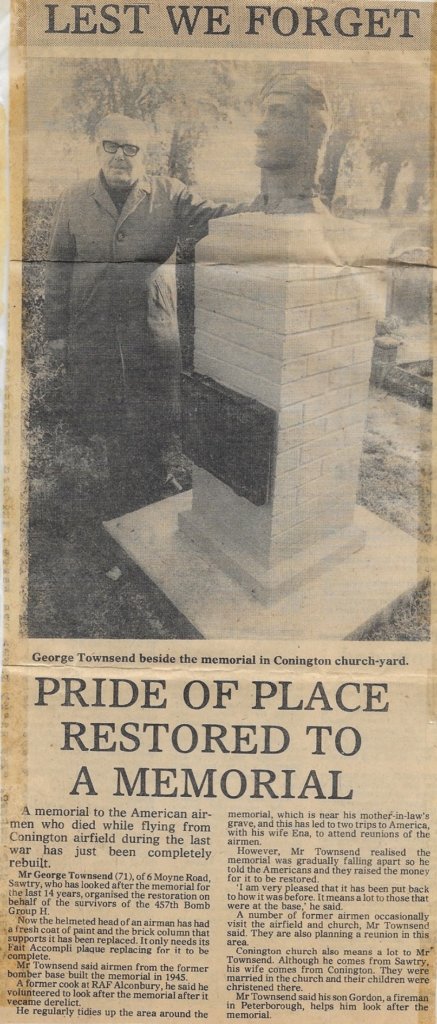 (photo credits Sheila Holtzen)
(photo credits Sheila Holtzen)
March 3rd 1982 (from the newsletter)
TO: All Former Members of the 457th Bomb Group, Glatton, England
From: the 457th Bomb Group Monument Restoration Committee
I am asking your help in financing the rebuilding of the 457th BG monument located in the old church yard in Conington, England – right adjacent to our old base.
In 4945 Lester Fried, amember of our S-2, conceived, designed and built a monument in the church yard. It was dedicated on 30 May 1945 by Colonel Rogner, our Chaplain Canon Wayne of Conington Church and Fried (Les Fried is also a member of the current restoriation committee)
The original monument was some six feet tall with the sculptured head of a helmeted airman on top. It face the runways as if wiating the return of the planes and men. (Some 86 planes never returned along with some 807 flyers who were killed, missing, became POW’s, interned or escaped and evaded)
The column had a wreath with the Group Motto ‘Fait Accompli’ on the front side. Sometime during the 1970’s our current Association President, Dan Graham, visited England and added the inscription, “Lest We Forget – In Perpetual Memory of Those Valiant American Airmen of the 457th Bomb Group (H) Who During World War II, Gave Their Lives That Freedom Might Prevail.”
This monument, although being maintained by some dedicated English civilians, reached an alarming state of deterioration in recent years. In 1979, another effort was made to restore the crumbling monument. This well intentioned effort did not produce satisfactory results in that it did not produce a monument that we could be proud of or that was durable or maintenance free.
At our 1981 Fireball reunion in Colorado Springs, we again deiscussed our monument. Many attendees were not satisfied with the recent restoriation results. It was decided that we should restore or rebuild this monument so that we would have a memorial befitting the sacrifices and dedication efforts of all our people. (It was not just the flyers that won the Air War. They would not have accomplished anything without the dedicated efforts of every person on the base. So this meorial is for all of us.) A committee of five volunteers was established to do the job. We also asked Bernard Bains, a UK citizen from Peterborough, a 457th historian and an attendee at the Colorado Springs reunion, to be our UK representative.
I think everyone wanted to preserve Les Fried’s original concept. But all that was left of the original monument was the sculptured head, which had cracked, been cemented back together, painted an now placed on top of a unevenly laid column of painted bricks. In addition to preserving the Fried concept, we wanted a durable monument, something that would not require maintenance and something we could be proud of in a aesthetic sense.
After lond discussions with Bernard while he was in the US., telephone discussions with committee members, lots of letters with committee members and Bernard, we selected one of four proposals submitted by two contractors. I am confident this will meet the criteria set forth above.
This monument will sit on paving slabs set in a concrete base. The column itself will be of Portland stone which is hard in texture and light greyish in color. It is used as a facing for many British government buildings and is also the stone used onm the “wall of the dead” and in the chapel at the American Cemetery at Cambridge. The column has a 3-inch bevelled base slab and three cubic blocks of 18 inches each. A newly carved head, using Fried’s original sculpture as a model will be mounted on top. Overall, it will be six feet tall.
Now we need help to pay for it. We have some money from previous fund and we transferred the B-17 money to this fund. We also have many pledges from 5.00 to 200 each. But we need more. By the time you receive this letter, I will have given Bernard the “go ahead” and Homer will have sent the first check to start the work. The contractor says he can finish in 60 days. So please respond today and help us complete this project. All individuals contributing 50 or more will receive a 457th Bomb Group Insignia Badge as described in the most recent 457th Newsletter as well as in the 8th Air Force Historical Society News. This is a beautiful badge. Money made from the sale of this badge helps support the maintenance and operation of the Sally B, a B17 with our 457th triangle U amrking that flies out of Duxford England. So we are really helping two worthwhile causes. Any money received over and above the amount needed to pay for the monument, the cost of printing and mailing this solicitation plus the cost of badges, will be transferred to the 457th Association general fund.
Please act now including those who have made pledges and make cjecks to the “457th BG Stone American Fund” and mail them to –
Homer Briggs, Secretary/Treasurer
The 457th Bomb Group Association
811 Northwest “B” Street
Bentonville, Arkansas 72712
I have asked Homer to publish a financial report in the newsletter on this project when it is complete.
Sincerely,
Thomas A. Goff, Committee Chairman
Joseph Falcone
Lester Fried
Lelsie R. Peterson
Neil C. Schroeder
February 1983 (from the newsletter)
The above pictures show our rebuilt “Stone American”. It is my pleasure, as chairman of the restoration committee, to tell you that the job is finished and all bills are paid. Each contributor should have received a set of two photographs. If not please contact Homer Briggs and he will mail them to you.
I am especially pleased with the completed monument. I think it is beautiful, durable and maintenance free. We used Les Fried’s original ideas as a model, is carved from the same Portland stone as used for the blocks. You will also note that in addition to the Fait Accompli wreath. Also Les’ idea, and the lest we forget…saying, we have added the Eighth Air Force logo, a B-17, A triangle U and the 457th BG identification. This approximate 6” monument sets on 2” paving stones which are set in a concrete base with edging slabs all around.
I personally, and I am sure I sepak for all the committee members – Joe Falcone, Les Fried, Les Peterson and Neil Schroeder, plus president Dan Graham, vice president Don Sellon, and secretary/treasurer Homer Briggs – thank each of you for your contribution which made this possible. We must not forget that probably the one person who contributed the most effort and had to put up with my constant demands for more and more information was Bernard Bains of Peterborough, we could not have done this without him. We all owe him a VOTE of appreciation.
Sincerely,
Thomas A. Goff, chairman


1983/1984 DATE UNKNOW (from the newsletter)
Lester Fried died of cancer after many many months of cancer. Les and Rose attended many of the reunions. Rose wrote that the tickets and plane fare to Houston had to be put aside, then Les planned once more to attend Rapid City and see all of his buddies. He died in august 1984.
Les was an artist and sculpter. De designed and sculped the monument “Stone American” in 1945. It was erected in the Connington churchyard over looking the Glatton Airbase. He made a clay model and took it to the commanding officer at Connington airfield, Col. Harris Rogner and suggested that the memorial should be built to commemorate the deaths of servicemen killed while on flying missions from the base, Col. Rogner was enthusiastic about the idea and gave Les the ‘go ahead’ to build the memorial. The memorial with the bust of an American serviceman at the top was unveiled on May 31st 1945. Col. Rogner performed the unveiling ceremony by pulling a parachute from the top if the memorial. Les Fried said: “It was a very touching occasion. For a number of servicemen based at Conington lost their lives on missions with the 457th Bomb Group, which was named the ‘ Fireball Outfit’. Mr. Fried served in the intelligence section at the base and was responsible for briefing pilots and their crews before they left for bombing missions. The 457th remodeled the monument in 1982. Les also designed the squadron insignias for the 748, 749, 751, the 750 never got around to asking me to designs one for them and so I missed on that.
We have a lot to thank Les for and will miss him very much.
1991 DATE UNKNOWN (from the newsletter)
Word from Bernie Baines comes to tell us that the memorial at Connington has been mended.The water had run under the foundation and would have frozen and caused cracking…so the necessary mending… This was paid for by sending Bernie several of the B-17 pictures, which he in turn sold. Also he purchased wreathes for the Memorial Day Services at Cambridge American Military Cemetery. And also the Glatton monument. This leaves a small balance for the 1992 wreathes.
February 1994 (from the newsletter)
This photo was sent to us by Bernie Bains who took it, when he and Tom Goff visited at the museum at Barksdale Air Force Base in LA 1993. It is the original head, by LES FRIED, which was put on the old monument at Glatton in 1945. When it was replaced, the old one was taken to Bernie’s home and in turn Tom Goff made the necessary arrangements to have it flown back to the USA from Mildenhall.
From the webmaster: just before I added the article from the February 1994 newsletter I received three beautiful photos from Robert Jackson, son of Lt. Edwin S. Jackson. One of the photos was, as written in the article above, the head and plaque of the memorial sitting in Bernie Bains’ garden. The photos were taken in October 1982.
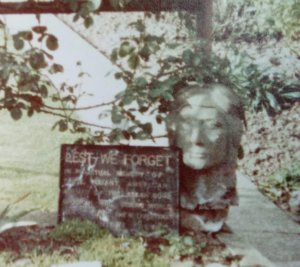
October 2000 (from the newsletter)
PLAQUE HONORING BERNARD BAINS ATTACHED TO 457th BG MONUMENT IN CONINGTON CHURCHYARD
Through the dedicated efforts of John Walker of Peterborough, a stone tablet honoring the memory of Bernie Bains was prepared, affixed to the east side of the column of the 457th Bomb Group monument in Conington churchyard. The plaque was dedicated during Mini-Reunion ceremonies at the churchyard on May 28, 2000. The tablet idea was originated by Tom Goff and Craig Harris, and the wording was developed by John Walker, Will Fluman and Will Fluman Jr. It reads:
IN MEMORY OF BERNIE BAINS
PETERBOROUGH
1918 – 2000
HISTORIAN AND FRIEND OF THE 457th
The tablet was contributed by Goff, Fluman, Harris, Nancy Henrich, John Pearson, Ken Nail and James Bass. We are grateful to John Walker for finding the original builder of the monument, and engaging him to make, engrave and mount the plaque in time for the Mini-Reunion. (Above right – Jerry Silverman speaks to Rex Burke in photo by Becky Harris Moore.)
2018
The original head, made by Lester Fried in 1945, of the memorial is still on display at the Barksdale Global Power Museum.
Here are a few photos of the head.
1945 – 2019
Many years have past since the Stone Airman was unveiled. During all these years veterans and their families have visited the memorial to honor those who did not return and paid the highest price. Here is a collection of the Stone Airman monument throughout the years.
Here is a collection of visitors. If you have a photo of a veteran visiting the memorial please contact the webmaster and I will gladly add it to this collection. Collection of visitors.


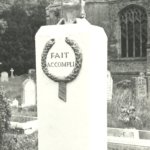
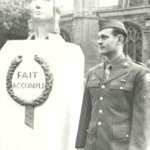
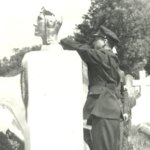
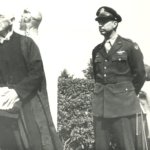
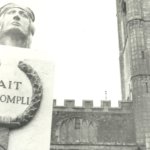
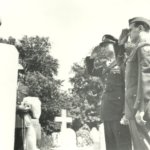
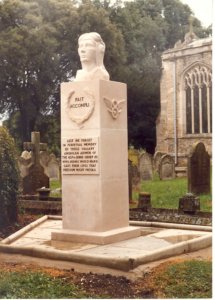
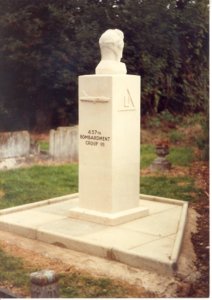
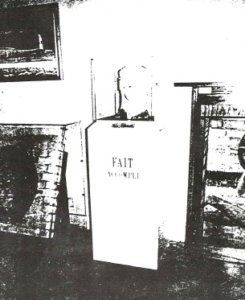
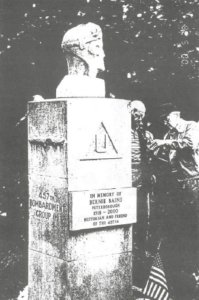
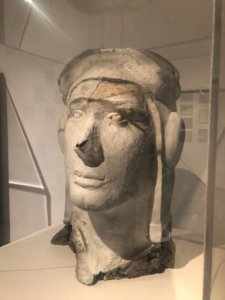
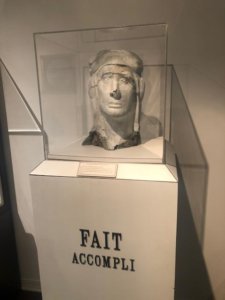
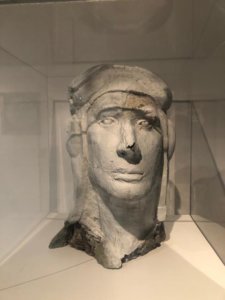
I noticed in one place the Churchyard is named Glatton cemetery. Please be aware that even though the base was named Glatton by the Americans, it isn’t Glatton cemetery. The457th base was in Conington village, and it is Conington Churchyard cemetery. I have several relatives and friends in that churchyard.